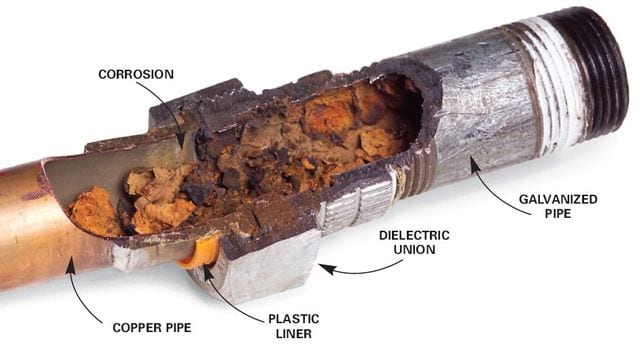What You Need to Know About Galvanized Pipes
We inspect a lot of homes. Some are as old as… well, they’re just really old. Naturally, a common question we get from homebuyers and sellers is around galvanized pipes in older homes.
Should you get rid of them?
To put it bluntly, the answer is yes.
We haven’t been using these types of pipes since the ’60s (and for good reason). If you still have them in your home, your running water is at risk of being contaminated.
Let’s figure out why.
RELATED: WHAT IS AN IRRIGATION INSPECTION?
What Are Galvanized Pipes?
Galvanized pipes are steel pipes dipped in a zinc coating. This practice (now referred to as galvanizing) came to be once we discovered that the typical lead piping leads to — you guessed it — lead poisoning.
To correct over 70 years’ worth of municipal lead piping, city builders found galvanizing to be the easiest solution. Between the end of World War II and 1960, galvanized water supply piping became the most common material in homes to provide potable (drinking) water.
What’s so great about it? The design of galvanized pipes helps prevent corrosion and rust on these steel metal pipes. By dipping lead pipes into molten zinc, corrosion and rust, by all appearances, seemed to completely diminish.
Unfortunately, we soon found out that this is like putting a bandaid over a stab wound.
Why Are They Bad?
To be fair, these pipes did perform fine for a few years. However, we soon discovered that after decades of wear and tear, this galvanized/zinc coating diminishes, and corrosion sets in.
And the worst part is that the rust often goes unseen because it starts from the inside. The pipes also can collect small deposits of lead particles, which can enter your drinking water.
Here’s a video from Waterjet Channel that shows exactly what galvanized pipes look like on the inside after years of corrosion:
You can see where that’s a problem.
Aside from the potential health concerns, corroded pipes can also cause other problems. Here are some signs you need to replace your lines as soon as possible.
- Leaks: Corrosion or rust on the outside of your pipes (usually around the joints) will eventually cause leaks. If the water in your house doesn’t come out in a steady stream, there may be a leak in your pipes.
- Water Discoloration: The iron and minerals in your pipes can turn your water brown. A simple brown stain near your tap is also an indicator of rusted pipes.
- Low Pressure: Corroded pipes cause roadblocks in your water supply. As a result, you may find that you have low water pressure. If some taps have better pressure than others, it could be that you do have some newer pipes. This is why you need a home inspector to analyze your entire pipe system.
To make matters worse, this can also impact insurance rates because these pipes can increase your likelihood of a damaging leak. In fact, some insurance companies may not even offer you insurance when they’re present.
RELATED: CAST IRON PLUMBING – THE ADVANTAGES AND DISADVANTAGES
How Can I Tell if I Have Galvanized Pipes?
Unfortunately, despite these pipes being out of rotation for nearly the past 6 decades, we find that there are still houses with galvanized pipes. We’ve even seen them in homes built in the ’80s!
Your best option is to hire a home inspector to get a detailed report of the state of your pipes. However, if you want to get an idea of the state or type of pipes your home has, here’s how to check:
- Find where your piping enters the house: This could be where your water meter is or near the shut-off valve, usually outside.
- Take a look at the pipes: You can lightly scratch them to reveal their actual color if they have paint covering them. Do they look like plastic or a copper penny? If so, you’re good! When your line looks like a silver or grey metal (with threads), it’s galvanized steel. Aka, you have galvanized pipes.
How Long Do Galvanized Pipes Last?
It’s hard to say. In the early years of using this protective piping, people thought it would last upwards of 100 years. However, a poor galvanizing technique can dwindle that time frame down to a 30-40 year period.
Considering galvanized pipes haven’t been installed in homes since the 1980s (at the very latest), that means your pipes have around 40 years of wear and tear. Even if the galvanizing job is exceptional, there is likely a significant amount of corrosion in your lines.
Which means it needs replacing.
Make sure to consider this and do further research during your inspection period.
RELATED: UNDERSTANDING, RECOGNIZING AND REMOVING CLOTH WIRING: YOUR COMPREHENSIVE GUIDE
Replacement Pipe Options

If your latest home inspection reveals you have galvanized pipes, it’s worth negotiating to get them replaced. In the meantime, consider which type of pipes you would like in your new home. Here are your options:
- Copper Pipes: This is probably the most common piping in American households. There are 3 different types of copper pipes. The thinnest (M) copper pipe lasts around 20-50 years, while the thickest (K) copper pipes can last 100 years!
- PEX: PEX (cross-linked polyethylene) is a durable yet flexible tube that has become popular over the last few decades. Unlike copper pipes, they aren’t prone to corrosion, and they can withstand heat and freezing temperatures. You’ll find these in black and white or blue and red colors. The life expectancy of PEX pipes is 40-50 years.
- Plastic PVC: Your standard PVC pipes (polyvinyl chloride) are easily recognizable. Made out of white plastic, these pipes last 25-40 years. Their longevity depends on the environment they’re in. For example, PVC can warp in extreme heat, and underground soil conditions can cause severe damage. Thankfully, CPVC pipes (chlorinated polyvinyl chloride) can withstand hotter temperatures compared to standard PVC.
How Much Does It Cost To Replace Galvanized Pipes?
If you look at the chart in this post, you’ll see that copper pipes alone have several tier pricing options. Suffice to say that the type of pipe you choose to replace your galvanized pipes with, along with how much piping you need, will determine the overall cost.
Most professionals agree that you can expect to pay anywhere between $2,000-$15,000 to replace galvanized pipes. The price range depends on:
- Whether you replace them with copper, PVC, or PEX pipes;
- How much piping you need to replace;
- How large your home is;
- The experience and location of your plumber
The Bottom Line
Check your home inspection report to see what type of water supply pipes you have– especially if you have an older house. If it’s a home built before 1960, chances are you might see a plumber in your future.
This is one of those hidden issues in homes that you may not want to roll the dice with. We’re not saying galvanized pipes are all necessarily “bad,” but they are no longer installed and are probably nearing the end of their life at this point.
We suggest if galvanized pipes are present, you consider having them replaced by a qualified plumber.
Not only will you sleep better at night knowing you and your family are drinking safer water, but you might also save a lot of headaches, property damage, and money by replacing any galvanized pipes with proven, modern materials.









